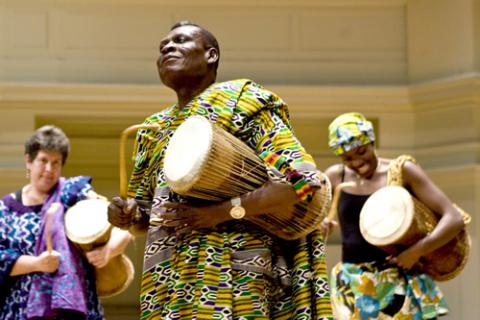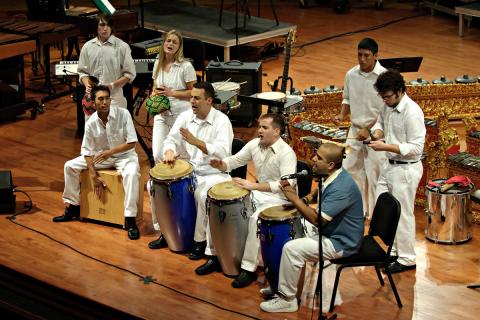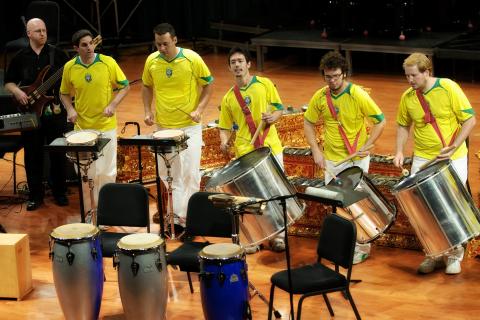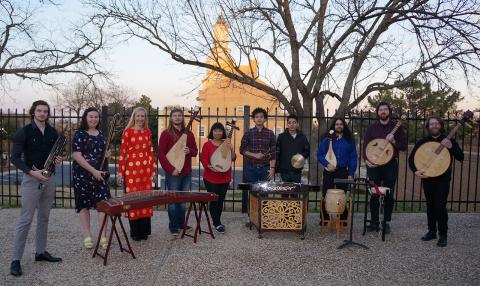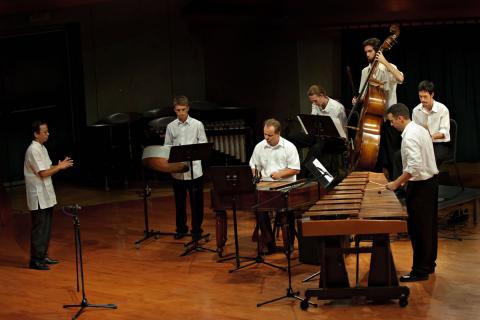The music that the African Ensemble is performing is a small part of the diverse and rich musical heritage of Africa. The music is of the Ashanti people of the central region and the Ewe-speaking people from the coastal region of Ghana, West Africa and is characterized by its "hot" rhythmic content. The instruments contained in this ensemble are the Gankogui bells, Axaste, and many carved drums including the Kaganu, the Kidi, the Sogo, the Atsimevu, the Atumpan, and the Donno.
Global Music Ensembles
- Global Music Ensembles Home
- African Ensemble
- Afro-Cuban Ensemble
- Brazilian Ensemble
- Bwana Kumala Gamelan
- South Indian Cross-Cultural Ensemble
- UNT Chinese Ensemble
This ensemble introduces students to the techniques and rhythms of Afro-Cuban folkloric and popular music. This music, born of African slaves transplanted to Cuba in the 17th and 18th centuries, is rich in West African history and culture. The rumba family of folkloric styles includes yambu, rumba Columbia, and guaguanco and can be traced directly to the Yoruba people in Nigeria. These traditional styles, in addition to the popular cha-cha-cha, mambo, and the mozambique are performed by the ensemble.
Escolas de Samba, or "Samba Schools," are part of the tradition of the Brazilian Carnival street parades. Every year, these ensembles, which number in the thousands, are formed from various members of different communities and take to the streets during the Carnival celebration. One ensemble alone can have as many as 600 percussionists and up to 4000 dancers. The style of Samba that these ensembles perform is called Batacuda. The Batacuda ensemble consists of a variety of percussion instruments such as the Caixa, the Pandiero, the Tambourim, the Frigidera, the Agogo Bells, the Reco-Reco, the Ganza and Chocalho, the Repinique, and Surdos.
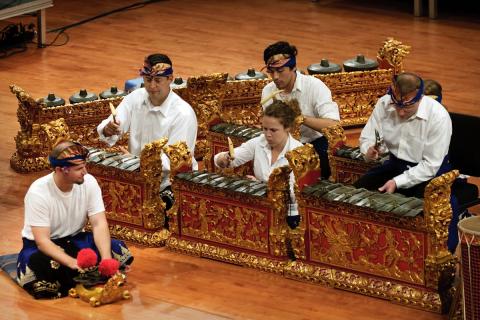
Gamelan, a term for various types of orchestras played in Indonesia,is the main element of Indonesian traditional music. In Bali, orchestras of tuned gongs, bronze kettles, bronze metallophones, bamboo xylophones, drums, cymbals and flutes fill the night air with animated music. UNT students explore this unique musical genre of Balinese Gamelan weekly and present concerts and clinics every semester. The UNT Bwana Kumala Gamelan orchestra has unique carvings on the frames, which includes scenes from the Indian epic, the Ramayana, adding to the performance enjoyment.
Founded in January 2016, The UNT Chinese Ensemble is the first Chinese ensemble established at a Texas university. Directed by renowned pipa soloist and traditional Chinese music director, Yuxin Mei, the ensemble uses Chinese instruments and plays in the traditional "Silk Bamboo" style. The UNT Chinese Ensemble was invited to perform for the Society for Ethnomusicology Southern Plains Conference in 2016. As the Special Performance Guest, they will perform at the Asian Festival in San Antonio, 2017 and will give a performance at the Houston Traditional Chinese Music Spring Concert in May, 2017. In summer 2017, the UNT Chinese Ensemble will perform at the Muse Festival both in Los Angeles and Beijing (invited by the China Conservatory).
Contact: Yuxin Mei, Director (YuxinMei@my.unt.edu)
The Indian percussion ensemble developed in South India as early as the 4th century B.C. due to the availability of a wide variety of percussion instruments.
These instruments include Mridangam, Ghatam, Kanjira, and Morsing. Traditionally, the ensemble is improvisatory in nature with a healthy spirit of competition among the performers.
An "Avanaddha Kutapa," consisting of 24 drummers, is still performing during important rituals in the Temple of Tooth in Kandy, Ceylon. The ensemble performs compositions based on Karnatic music, a South Indian microtonal, modal art form which is built upon a highly developed theoretical foundation, with melody and rhythm as its two vectors.
Director:
